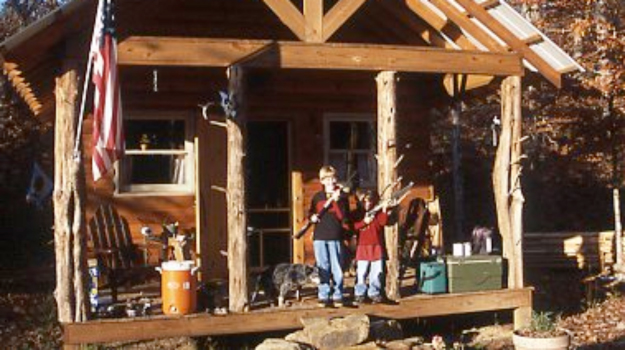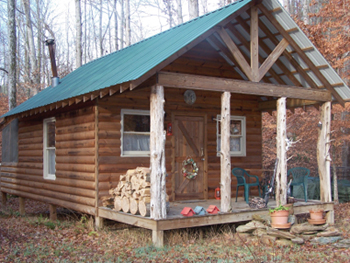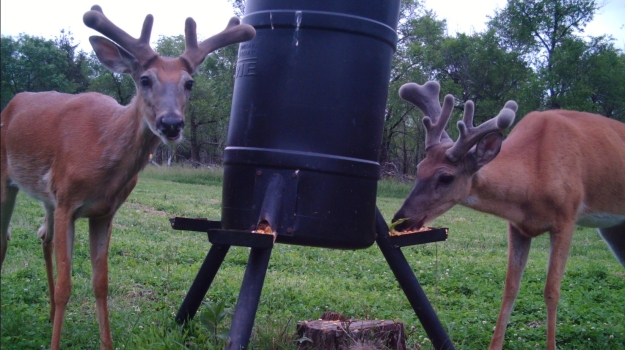
Building your Dream Cabin
By Mark Thomas
My wife Vikki and I looked for our forestland for about 10 years, saving all the while, and finally bought 101-acres of wooded mountain land in central Alabama. Vikki was born and raised in “Booger Holler,” and she’s made great progress. She’s wearing shoes now about half the time, sometimes regular. She had to fill a “tater-sack” with cotton “leavings” every day after school in her childhood. Leavings are what is left after the pickers have already gone through. She grew up poor, eating dried beans for breakfast; she drank water for lunch, and just swelled up for supper. We are kind of alike in that regard. My family was so poor back in the Missouri Ozarks where I grew up that lots of nights Momma would gather us “chilren” (seven of us) around the supper table, pull a “Better Homes and Garden” cookbook from the shelf, and just read us a recipe for supper. I had a brother that was hard of hearing, and he nearly starved to death. I grew up ‘coon hunting off the back of an old Missouri “jumpin’ mule.”
We bought our land 12 years ago, and added another 80 acres adjacent to it a year later in a 1031 exchange. We built our log cabin the following year. We are currently swapping for an adjoining 42-acre parcel now, which will leave us with around 223 acres, which is enough for us, and all squared up. There’s about 40 acres of mountain longleaf, 80 acres of a loblolly/longleaf/oak/hickory mix, and the rest is mostly bottomland hardwoods with some huge white oaks and enormous beach.
I’ve known J. Wayne for many years, and knew that he had built a log cabin on his land. J. Wayne was just inducted into the Legends of the Outdoors National Hall of Fame. Vikki and I drove over to J. Wayne’s place with another couple who also had bought some land and looked over his cabin, and thought that we wanted to build one just like it. It’s called an “Alaska Trappers Style Log Cabin” and you can get the blueprints from J. Wayne, which is what we did. The only modification we made was to add the sleeping porch onto the back, which was Vikki’s idea. (Always incorporate the wife’s ideas into the plans). Our friends ended up buying a big red metal shipping container for their cabin. One big advantage is that they can bake bread all year long, and they don’t even have a stove!
Choose the location for building your cabin very carefully. We walked our land many times before settling on a place. We have hills, hollers, mountain sides, side terraces, valleys, creeks, and all sorts of possible places. Think what you want your cabin for and how you are going to use it and that should help narrowing down your choices. The area we finally selected was the same place where there was once an old home place, complete with a hand-stacked field rock foundation and an old rock spring house with walls over 4 feet thick, which we are rebuilding. It has a creek on three sides, and is cool even during the summer.
We built our log cabin in 29 days of straight work, camping out most of the time, during the dead of winter. It was cold enough to freeze your drinking water, and the ground was frozen most of the time. The frozen ground facilitated hauling in all of the materials, which I did on a 26’ gooseneck trailer. We bored our main foundation beam holes with an 18-inch auger with my tractor, and put 400 pounds of concrete in each hole. I modified the blue prints a tad and switched from railroad ties that were listed to 8X8” treated posts. It’s 16’ wide by 36’ long, with a front porch, a main room, a small sleeping loft, and a screened sleeping porch in back with a lean-to roof. We used treated floor joists and ¾” treated plywood for the decking and 2X4’s to frame it in, and 2X8 double-lapped half rounds of white pine from eastern Tennessee both inside and out. Anything that was exposed to the weather was built with treated wood. Our floors are tongue-and-groove longleaf pine. The green tin roof is 26-gauge. We heat with a small wood stove and cook with a three-burner gas stove top. I built all of the shelves, cabinets, kitchen table, stairs to the loft, and hand-hewn longleaf pines for the interior beams. I cut four cedar trees and limbed them up for our front porch beams and built our stairs with native rocks. We treated the outside of the logs with a log stain that included an insecticide to ward off carpenter bees, of which we have very few. We also used oversized windows for a better view.
This design, with the modification and sleeping loft, gives us just over 700 square feet of living space. This includes the front porch (8’ X 16’ or 128 square feet), back screened sleeping porch (8’ X 16’ or 128 square feet), sleeping loft (8’ X 16’ or 128 square feet), and our main room (16’ X 20’ or 320 square feet). The main room is divided into three areas including a living room, kitchen, and bedroom.
We furnished our cabin with an oversized day bed in the back porch, two rockers and a sitting bench on the front porch and a king mattress up in the loft along with a night stand and light. Our main room includes two couches with leather trim and an armoire situated around our wood stove, two rocking chairs by the big window, and a bed in the corner. Our kitchen includes a table with four chairs, cabinets, shelves, a three-burner propane stove, and a water dispenser. We have no electricity and don’t want any, not even a generator. We light with lamps and oil, and use propane or charcoal for cooking.
I also built a log outhouse and a log outdoor shower, complete with tiled floor. We just established a half-acre food plot across from our cabin to benefit wildlife. This also increases sunlight and enhances the breeze across our front yard. We’ll add an old-time cedar split-rail fence next. .
 We have three reasons for buying our land and building our log cabin. Our primary purpose is to relax on the weekends and get away from the cell phones, text messages, emails, phone calls, and computers, and none of these things are allowed at Booger Holler and none of them work there anyway. We’re so far back in the sticks we have to pipe in sunshine. We are about 7.3 miles from the nearest paved road.
We have three reasons for buying our land and building our log cabin. Our primary purpose is to relax on the weekends and get away from the cell phones, text messages, emails, phone calls, and computers, and none of these things are allowed at Booger Holler and none of them work there anyway. We’re so far back in the sticks we have to pipe in sunshine. We are about 7.3 miles from the nearest paved road.
The second purpose is to raise grand-babies. We have three grandsons (Jacob, Sam, and Andrew) and we call them by their beloved nicknames – Chitlin’, Cracklin’, and Fat Back, in that order. We plant a garden together every year, and I asked Chitlin what he wanted to plant this year, and he told me, “Paw Paw, I want to plant pickles and mashed taters.” And that is exactly what we planted.
And of course, the third reason is to raise opossums. We currently have 9,000 breeding pairs and it’s quite an operation. We are proud members of the “Opossum Growers and Breeders Association of America,” and our motto is “A Registered Opossum is a Better Opossum.” We were going to relocate our opossum ranch to northern Maine but when word got out the folks up there got all excited and I started getting all sorts of calls. I just never realized that they would be so happy to see a new business relocate up there. The Commissioner of Agriculture for Aroostook County called and asked me if I had any idea how deep the snow was up there in the winter, and how were our opossums going to get along. I told him that I figured the snow was hub-deep to a ferris wheel and that I didn’t just fall off of no tater wagon. Me and the Missus had been saving up our Bud Light bottle caps all year and we were going to stick them onto their feet with a hot glue gun sort of like snow shoes. Well, the town-folk of Presque Isle, Maine, commenced to clamoring something fierce. Seems like the sight of us driving our opossum herd down Main Street right through town was just too much for them to bear so we are staying put for the time being. They have laws up there requiring shoes in public anyway, which made the Missus mad.
We were fooling around the cabin the other day, Grandma was tending the herb garden and I was trimming some limbs along our road. I finally made it back to the cabin and saw a pan of soup simmering on the stove. Had my first bowl and it was pretty good, all spicy, so I had another. I was finishing up my third bowl when Vikki came in and asked me “What are you doing?” I told her that I was just sampling her fine soup. She said, “That’s not soup you idiot, its potpourri!” I told her that was sure a pretty name for soup but it seemed to me like she was just boiling sticks and leaves. Anyway, I told her to add an old yard bird, some potatoes, carrots, and an onion or two and it would be fine. Chunk it up! She just looked at me and shook her head.
Grandma and I were sitting on the front porch a couple weeks back with “Fat Back,” the other boys were playing in the creek, and he commenced to spin quite a yarn for a four-year old. He told us that before he was born, he was an “old man.” He rode on the back of a big elephant and he told us all about it, he could see for miles from up there. And, he often set on the porch just like ours in a rocking chair smoking a pipe. He also once killed a big grizzly bear that was chasing him. Shot him right between the eyes on a dead run. The stories went on and on. Wonder where he gets that from?
The whippoorwills started about dusk, the oil lamps came on, and the warm glow inside our little cabin filled the room. Chitlin’ likes to sleep on the screened back porch, Cracklin’ up in the loft, and little Fat Back nestles in with me and Grandma. We could still faintly hear the whippoorwills call as we dozed off into the kind of sleep that city folks can’t even dream of.




























